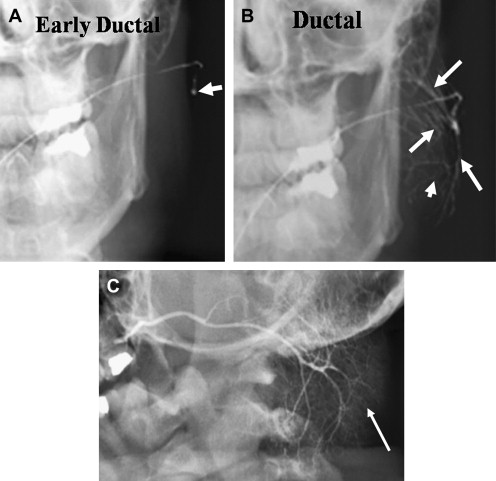The advent of sialoendoscopy techniques presents new challenges in the diagnostic imaging of the salivary glands. This article reviews the different diagnostic imaging approaches for work-up of patients before sialoendoscopy. The relative advantages and disadvantages of each technique and guidelines for application of the different techniques are discussed.
Diagnostic imaging of the salivary glands has undergone significant evolution with advances in cross-sectional imaging techniques. Prior to the advent of CT and MRI, sialography performed with x-ray techniques or under fluoroscopic guidance was the mainstay of evaluation of the salivary glands. The emergence of sialoendoscopy as a diagnostic and therapeutic technique for salivary disorders creates unique challenges in imaging. Each pathologic condition of the gland and duct is treated differently by sialoendoscopic technique; thus, radiographic identification of the various pathologies and their potential endoscopic complications is imperative. This article discusses the different diagnostic imaging approaches to evaluation of the salivary ductal system and the advantages of each technique in the diagnostic work-up for sialoendoscopy.
Conventional sialography
Conventional or x-ray sialography was first described by Carpy in 1904 and, although x-ray sources, contrast agents, and techniques have evolved, the essential technique remains the same. The examination begins with identification of the papilla of Stensen’s duct or Whartons’ duct ( Fig. 1 ). An important next step in the diagnostic evaluation before sialoendoscopy is the dilatation of the ductal orifice. Although sialographic techniques can be performed without dilatation, dilatation of the ductal orifice determines whether or not a sialoendoscope can be inserted without surgical papillotomy and whether or not there is significant stenosis at the orifice. Dilatation of the duct is achieved using incremental sizes of lacrimal probes. The lacrimal probes range in tip dimension from 0000 to 4 ( Fig. 2 ). The probe is inserted into the papilla ( Fig. 3 ) and gently advanced until resistance is met and the duct dilated using a circular motion of the probe. The next incremental size probe is introduced until the duct is dilated to the largest achievable size.
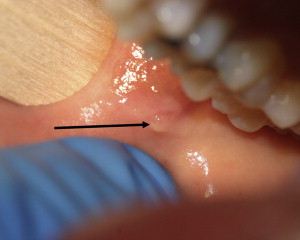
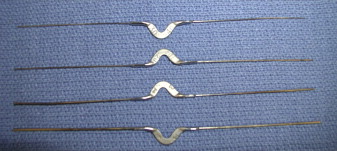
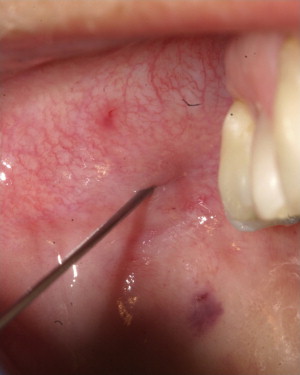
Once maximum ductal dilatation is obtained, the sialographic catheter is introduced. There are a variety of sialographic catheters available of different dimensions and end-hole or side-hole configuration. The Yune-Klatte catheter (Cook Medical, Bloomington, Indiana) was developed by Drs Heun Y. Yune and Eugene Klatte of Indiana University and is an end-hole teflon catheter ( Fig. 4 ) available in two sizes: 19 and 39. Generally, this catheter is more suitable for most Stensen’s ducts; however, the orifice of Wharton’s duct is not infrequently too small, even when dilated, to easily accommodate this catheter. Ranfac Corporation (Avon, Massachusetts) manufactures sialographic catheters in three sizes: 27, 30, and 31; the latter two sizes are likewise used for galatography. These are stainless steel end-hole catheters useful for Wharton’s duct and stenotic Stensen’s ducts ( Fig. 5 ). An alternative to commercially available sialographic catheters is to use the semirigid plastic sheath of a #24 angiocatheter (BD Angiocath peripheral venous catheter, Hamilton Medical Products, Mill Valley, California) ( Fig. 6 ), which is intermediate in tip dimension between the Yune-Klatte catheters and the Ranfac catheters.
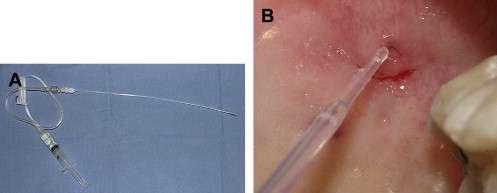
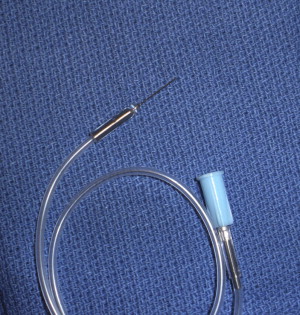
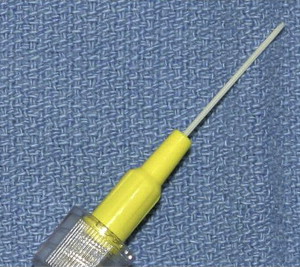
There are two iodinated contrast agents primarily used in conventional sialography: the oil-based agent, Ethiodol (Savage Laboratories, Melville, New York), or a water-soluble agent, Sinografin (Bracco Diagnostics, Princeton, New Jersey). Ethiodol contains 37% iodine in a poppy seed oil base. Due to its significantly reduced viscosity (0.5 to 1.0 poise at 15°C) and the fatty acid composition, which limit significant transductal permeability, Ethiodol provides better contrast of ductal walls, permitting improved identification of wall irregularities, including polyps, mucous/fibrin plugs, or granulomatous areas ( Fig. 7 ). It is advisable, however, to substitute Ethiodol with a water-soluble agent if sialoendoscopy is to be performed within 24 to 48 hours, as retained intraductal Ethiodol creates oil droplets or bubbles that may interfere with visualization at the endoscope tip.
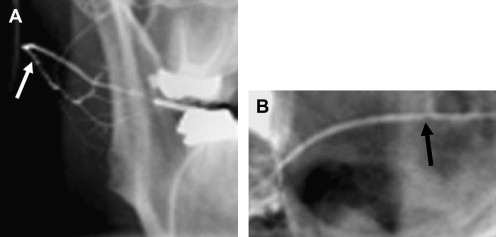
Prior to infusion of the sialographic contrast agent, a radiograph (or when performing the examination under fluoroscopy, a spot film) of the relevant area is obtained to verify the presence or absence of calcified sialoliths. Filling is accomplished using moderate constant hand pressure on the syringe plunger. Fluoroscopic filming should begin with the start of filling to identify obstruction or stenosis of the orifice or buccal (Stensen’s) or distal (Wharton’s) segment and should be performed in the anteroposterior (AP) plane ( Fig. 8 ). Moderate constant hand pressure on the syringe is important to ensure that ductal walls weakened by prior episodes of sialodochitis are not ruptured by the contrast bolus. Moreover, the relative amount of hand pressure required to infuse the contrast provides additional qualitative tactile information about the degree of stenosis and the need for balloon dilatation. On initial filling of the duct to the hilum, patients are turned to the lateral position and the remainder of the examination filmed with lateral views.

There are two major phases of contrast filling in conventional sialography: ductal and acinar ( Fig. 9 ). The ductal phase constitutes the majority of filling and consists of filling the major duct, hilum, and secondary and tertiary ducts. Acinar filling is achieved with contrast “blush” of the parenchyma and, before the advent of cross-sectional imaging techniques, was the preferred method for evaluation of salivary gland parenchyma. In diagnostic sialography performed for sialoendoscopic purposes, the acinar phase is not performed; filling is completed with contrast opacification of the tertiary ducts or as much as ductal pathology permits. Typically, parotid ducts can be sufficiently opacified with 1 to 2 mL of contrast, whereas the submandibular ducts may require as much as 3 to 5 mL of contrast. At completion of filling, the catheter is removed; patients are administered a sialogogue (typically approximately 1 to 2 ounces/approximately 30 mL undiluted lemon juice) that is expectorated. Postevacuation AP and lateral views are obtained to evaluate the presence or absence of contrast retention. Retention of contrast in the main duct or secondary/tertiary ducts in the absence of obstruction or significant stenosis is indicative of sialoparesis that may benefit from sialoendoscopic lavage.

